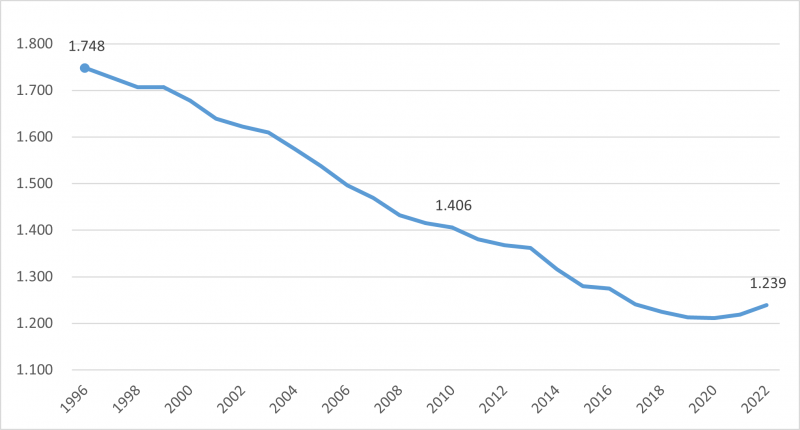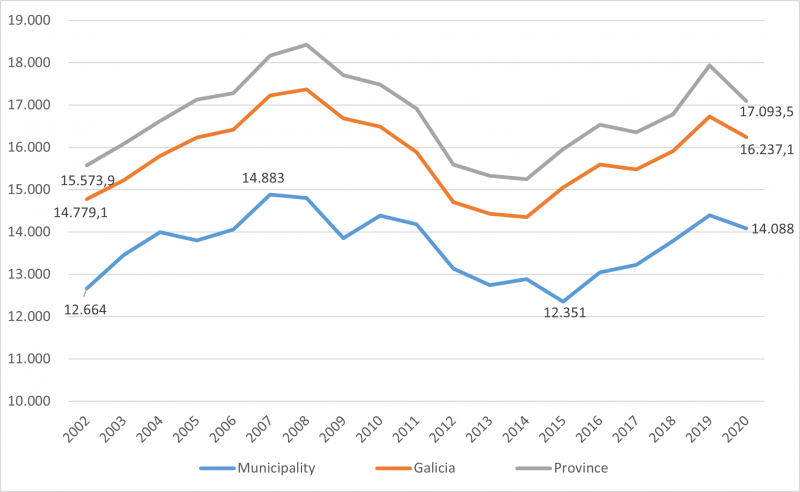
Introduction
The Municipality of Vilasantar is located in the region of Betanzos, in the southeast of the province of A Coruña, 40 kilometres from the provincial capital. It is an inland territory with just over 1,200 inhabitants and a surface area of 59.17 square kilometres, with a level of urbanisation of sparsely populated area, according to the Galician Institute of Statistics.
It belongs to the Ulla Tambre Mandeo Rural Development Group (RDG20).

Population and demographic structure
The population of Vilasantar experienced a constant loss of inhabitants from 1991 to 2022, with almost 660 people less, which means a loss of almost 35% of the population.
The decade from 2012 to 2022 saw a decline in the population of -9.4%. This population decline was parallel to a change in the age distribution that generated a progressive ageing of its population. Although all age groups have decreased since 2002, the age groups that suffered the greatest loss of population were those aged 16 to 64 years and those aged over 64 years, both of which decreased by 10%. The population under 16 has shown a slight recovery since 2012, with an increase of 3.5%.
This demographic ageing was reflected in the large narrowing of the base of the population pyramid and the widening of the top. There was also an increase in age, reaching 55 and a half years in 2022, eight years above the average for Galicia and A Coruña. The average age of women was much higher than that of men, with women reaching 58 years of age and slightly above 53.
The Total Dependency Ratio (TDR) in Vilasantar reached 81% in 2022, after an almost sustained increase throughout the whole period, despite experiencing a reduction between 2017 and 2020. In the last two years it changed course and stood at almost twenty percent points of the Galician and provincial level. The increase in the proportion of dependent population in Vilasantar since 1998 was significant and much higher than that recorded in the province and Galicia as a whole, despite the approach between 2018 and 2020, which confirmed the demographic decline and ageing that the municipality was experiencing entailed important social, economic, and cultural consequences.

Population dynamics in Vilasantar.

Evolution of the total dependency ratio of Vilasantar, A Coruña and Galicia.
Economy
The evolution of Gross Disposable Product (GDP) followed the same growth trend as that of Galician municipalities in general and the province of A Coruña. After an initial slight drop between 2010 and 2012, growth rates were consistently positive, particularly high between 2012 and 2016, until the 2020 period, when GDP fell by 8.5%.
Vilasantar recorded a higher impact than Galicia, with -7.7%, but lower than A Coruña, with -10.5%. The GDP of the municipality experienced a growth of 2.5% throughout the decade of 2010, contrary to what was experienced in Galicia, -2%, and A Coruña, -0.26%. In 2022, the municipal GDP ended up reaching a value of around 23.6 million euros.
The Gross Disposable Income (GDI) showed an evolution of growth. Between 2002 and 2019, the increase was 13.6%, similar to the 13% and 15% recorded in Galicia and A Coruña respectively. This growth made it possible to reduce the gap between the average household income to 14,400 euros per inhabitant in Vilasantar in 2019, 2,340 euros of the Galician average. The pandemic generated a generalised fall with a reduction of 2% in per capita income in the municipality to 14,650 euros in 2020, a smaller reduction than that experienced in Galicia, close to -3%, or in A Coruña, with -4.7%.
Using the number of social security affiliations as an estimate of municipal employment, between 2011 and 2022, Vilasantar experienced a stagnation in the number of affiliations, unlike the growth recorded at both regional and provincial level. Specifically, Vilasantar experienced a slight reduction in the total number of affiliations, with four fewer members in 2022 compared to 2011, while at Galician and provincial level there was a growth of 8%. In terms of sectors, the primary sector had a reduction of 20% since 2011. The secondary sector had a reduction of 5.6%. The tertiary sector gained weight with an increase in the number of affiliates around 14-15%.
In 2022, Vilasantar had an activity rate of 78%. The employment rate stands at 72%. The unemployment rate drops from 10.7% in 2011 to 7% in 2022, a rate lower than that of the territorial groups.

Evolution of Gross Disposable Income per inhabitant in Vilasantar, A Coruña and Galicia.

Evolution of employment, unemployment, and activity rates in the municipality of Vilasantar.
Energy resources
Vilasantar has an important energy infrastructure based on renewable sources, in particular hydro and solar photovoltaic energy. The installed capacity of hydroelectric power is 1.906 MW in 2022. It also has approximately 5.6 kilowatts of solar photovoltaic power installed. However, further diversification of renewable energy sources is essential to strengthen the municipality’s energy resilience and maximise its economic potential. The expansion of other forms of renewable energy, such as wind or biomass, would not only help to reduce dependence on a single source, but could also generate new economic and employment opportunities in the area.
The electricity consumption of Vilasantar in 2023 was estimated at 3,044.15 MWh. Residential consumption was 1,761.67 MWh. The consumption of services, including municipal services, was 839.92 MWh. Industry consumed 442.56 MWh.
Energy Policy Councils
Date of the first meeting:
26th March 2024
Number of participants:
18 people
Profile of participants:
- Staff of the municipality of Vilasantar: mayor, energy services company
- EC4RURAL project staff: UVIGO, ESPAZOCOOP, FEGAMP
- Citizens, entrepreneurs
Evaluation of the energy situation
Vilasantar has an important energy infrastructure based on renewable sources, namely hydro and solar photovoltaic. The installed capacity of hydroelectric power is 1,906 MW. It also has approximately 5.6 kilowatts of solar photovoltaic energy installed.
The mayor indicates that they have been working for months on the Vilasantar Energía proposal and that this meeting is a formal act for the constitution of the social and collective initiative. The council has made a preliminary study of the possibilities of developing an energy community in Vilasantar and intends to start with a 100-kW installation located on the roof of the municipal pavilion in the parish of Présara.
Dialogue between the parties
During the meeting, there was an open dialogue between citizens and the municipality about photovoltaic energy production. There was a discussion which highlighted the following:
The technicians of the energy services company Permae Ser presented the initiative of the Municipal Pavilion after having gone through the previous process from the beginning until today, when the association will be formally constituted.
From the EC4RURAL project, local initiative of Vilasantar is considered to be the most advanced and there is general satisfaction that the municipality is willing to take the planned steps.
Then the content of the governance model chosen for Vilasantar Energía is read, which is the non-profit association model. The most important points are discussed.
Conclusions
After the joint co-creative process, the first contact with the neighbourhood and local authorities have been positive. There is a real interest in the development of the rural energy community as they think about joint action and the benefits of making it happen.
As a result of previous work, the Energy Policy Council had already been created. This act created the legal entity that will encompass Vilasantar Enerxía, the local energy community. For this reason, the tractor group of the initiative was created.



